Tweed, Ontario, the north shore Stoco Lake, from east of the boat pier to the pavilion:
marshy shoreline, relatively shallow water with mud bottom supporting sedges and rushes, pondweeds, Fragrant Water Lily, Blue Flag, Sagittaria spp and Pickerelweed.
Some typical dragonfly species are the Widow Skimmer (Libellula luctuosa), Twelve-spotted Skimmer (Libellula pulchella), Eastern Pondhawk (Erythemis simplicicollis),
Blue Dasher (Pachydiplax longipennis), Halloween Pennant (Celithemis eponina), Slaty Skimmer (Libellula incesta) and Dot-Tailed Whiteface (Leucorrhinia intacta).
Damselflies apt to be encountered here are the Swamp Spreadwing (Lestes vigilax), Elegant Spreadwing (Lestes inaequalis), Tule Bluet (Enallagma carunculatum),
Skimming Bluet (Enallagma geminatum), Eastern Forktail (Ischnura verticalis) and the occasional Hagen's Bluet (Enallagma hageni).
|
|
Northeast corner of the Pavilion
|
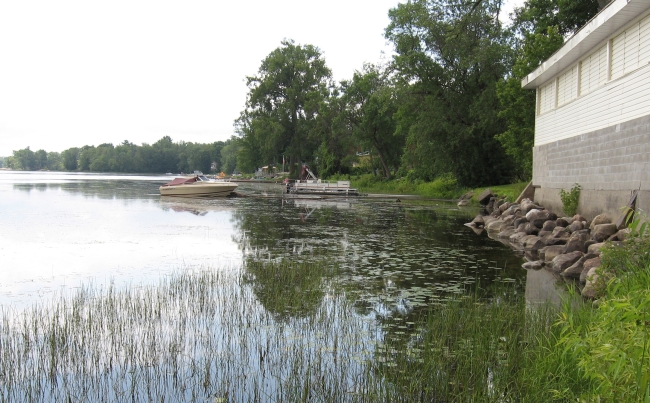
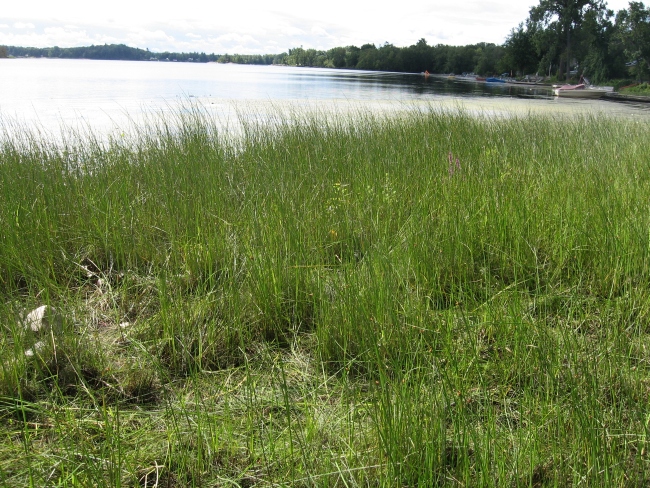
......................................................................
Between the pavilion and the boat pier is a stretch of beach with floating plants such as pondweed and Fragrant Water Lily rooted in the sandy substrate.
This is an excellent place to look for Orange Bluets (Enallagma signatum) and Vesper Bluets (Enallagma vesperum) late in the afternoon or early evening.
A Saffron-winged Meadowhawk (Sympetrum costiferum) has been recorded from this habitat.
Whenever they pass through this neck of the woods Wandering Gliders (Pantala flavescens) can be seen cruising above the water.
|
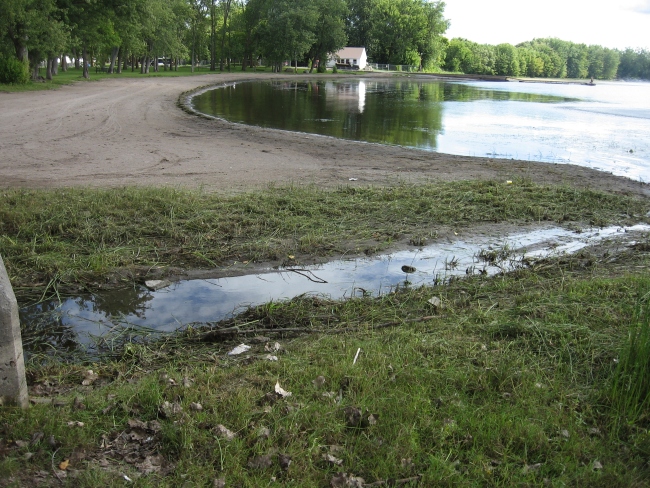
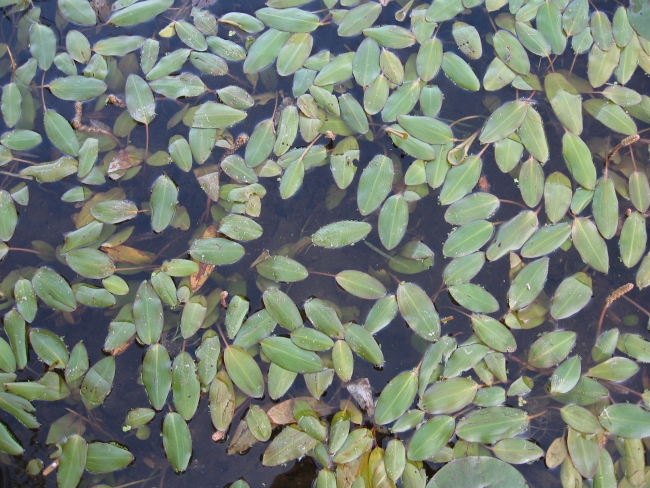
......................................................................
|
East of the Boat Pier – similar to the habitat near the pavilion but with more Pickerelweed and trees along the shoreline.
A good place to find Slender Bluets (Enallagma traviatum westfalli), Lilypad Clubtails (Arigomphus furcifer), Swamp Spreadwings (Lestes vigilax) and Mottled Darners (Aeshna clepsydra).
|
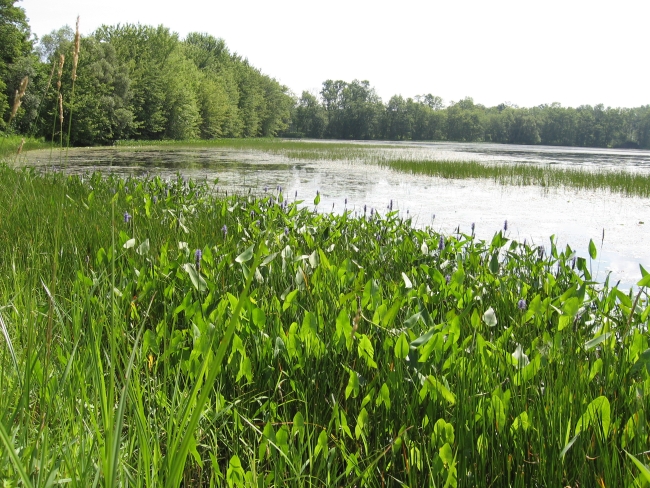
Tweed, Ontario, the Moira River, near the walking bridge and dam:
rock-bottomed river with fast flowing water, rapids and emergent rocks, but also quiet pools and backwaters.
The shoreline vegetation is mostly trees with a few small clearings supporting tall grasses and wildflowers.
Black-shouldered Spinylegs (Dromogomphus spinosus) and Lancet Clubtails (Gomphus exilis) perch on the emergent rocks;
Fawn Darners (Boyeria vinosa) can be seen cruising along the shoreline.
Uhler's Sundragon (Helocordulia uhleri), the Rusty Snaketail (Ophiogomphus rupinsulensis) and the Eastern Least Clubtail (Stylogomphus albistylus), three uncommon and seldom encountered species, make this part of the river their home.
The Ebony Jewelwing (Calopteryx maculata), Violet Dancer (Argia fumipennis violacea), Powdered Dancer (Argia moesta),
Stream Bluet (Enallagma exsulans), Rainbow Bluet (Enallagma antennatum) and the less frequently encountered River Jewelwing (Calopteryx aequabilis) inhabit this stretch of the river.
|
|
Moira River, looking south of the Dam
|
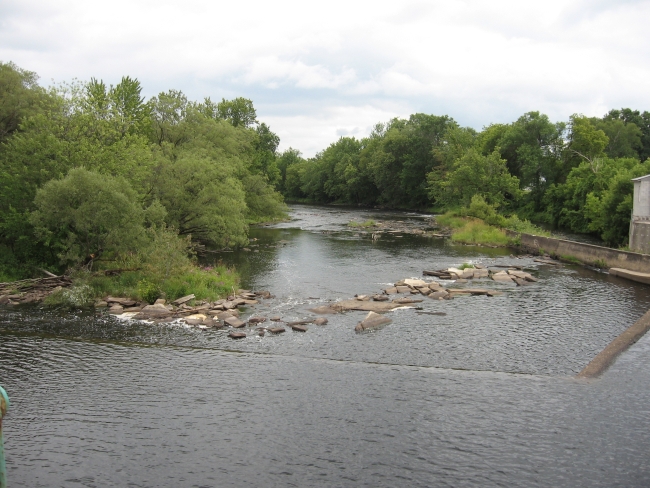
......................................................................
|
Pools of still water along the east bank –
Sympetrum species, notably the Band-winged Meadowhawk (Sympetrum semicinctum), breed in these quiet waters.
Also expect the Spotted Spreadwing (Lestes congener), Slender Spreadwing (Lestes rectangularis) and the Fragile Forktail (Ischnura posita).
|
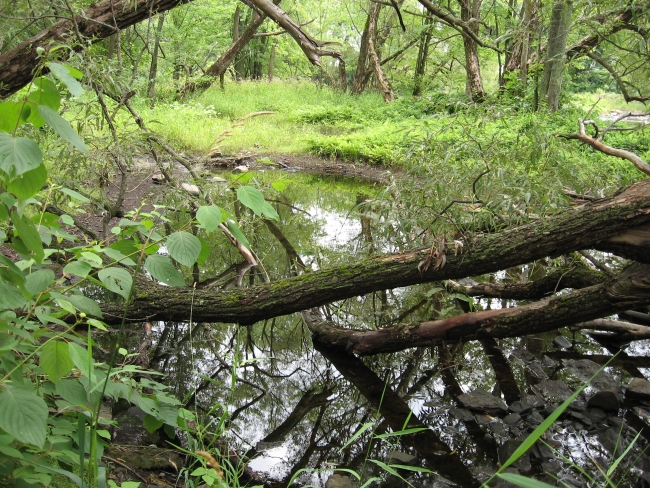
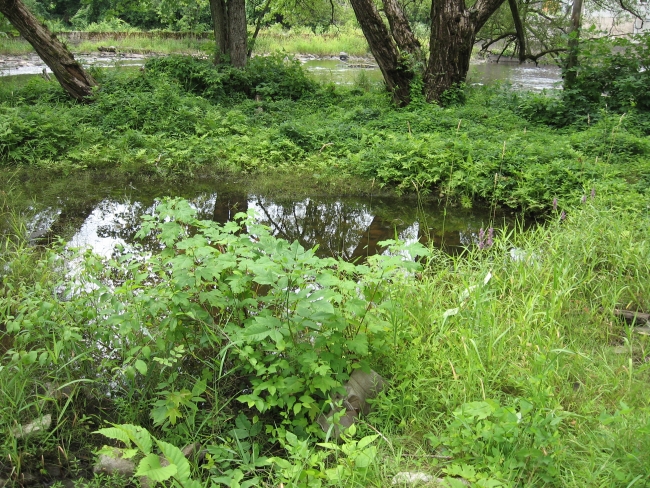
......................................................................
|
Standing on the east bank of the river, looking west –
a Rusty Snaketail (Ophiogomphus rupinsulensis) has also been recorded from a similar habitat a few kilometers further south.
|
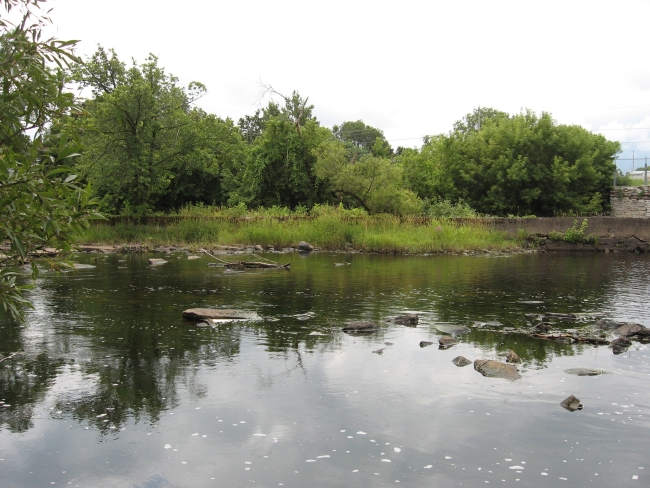
|
West bank seen from opposite side of the retaining wall (looking east)
|
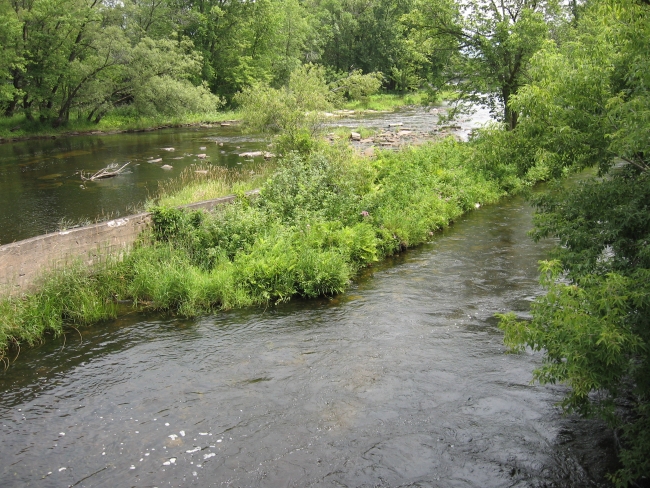
......................................................................
South of the old railroad bridge on the trans-Canada Trail –
this is also fairly typical of the habitat found at Collin's Point.
Stygian Shadowdragons (Neurocordulia yamaskanensis), both adults and exuviae, and a Swift River Cruiser (Macromia illinoiensis) naiad, have been found at this site.
Prince Baskettails (Epitheca princeps), Racket-tailed Emeralds (Dorocordulia libera) patrol the clearings and the trails,
Dragonhunters (Hagenius brevistylus) and Black-shouldered Spinylegs (Dromogomphus spinosus) forage along the shoreline.
|
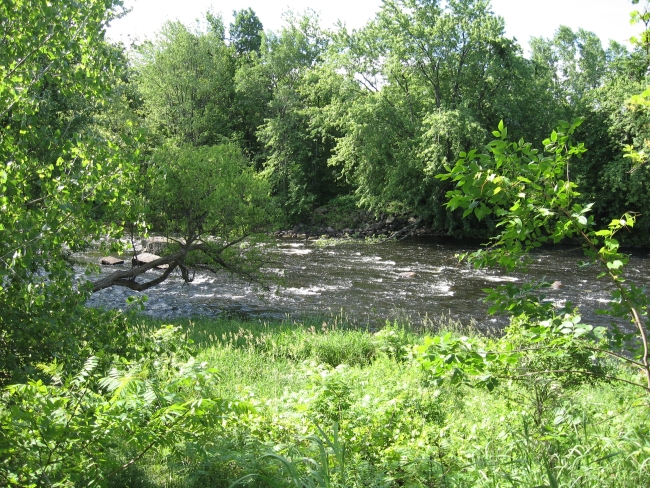
Tweed, Ontario, about ½ km west of town, a marsh bordering the trans-Canada Trail:
typical local marsh with Cattails, sedges and other emergent vegetation, various small willows, alders, dogwoods and some Tamarack.
A good place to look for the Frosted Whiteface (Leucorrhinia frigida), Belted Whiteface (Leucorrhinia proxima), Twelve-spotted Skimmer (Libellula pulchella),
Common Whitetail (Plathemis lydia), Four-spotted Skimmer (Libellula quadrimaculata) and Black Saddlebags (Tramea lacerata).
Most of the local Aeshna and Sympetrum species are represented at this marsh.
Many Enallagma species – particularly the Marsh Bluet (Enallagma ebrium) and Boreal Bluet (Enallagma boreale) – and the Taiga Bluet (Coenagrion resolutum) breed at this habitat.
Fragile Forktail (Ischnura posita) breed here and Sedge Sprites (Nehalennia irene) are abundant in the vegetation along the sides of the trail.
Spreadwings breeding at this locale are the Northern Spreadwing (Lestes disjunctus), Sweetflag Spreadwing (Lestes forcipatus), Emerald Spreadwing (Lestes dryas)
Slender Spreadwing (Lestes rectangularis), Amber-winged Spreadwing (Lestes eurinus) and Spotted Spreadwing (Lestes congener).
|
|
View of the marsh looking toward the north side of the trail
|
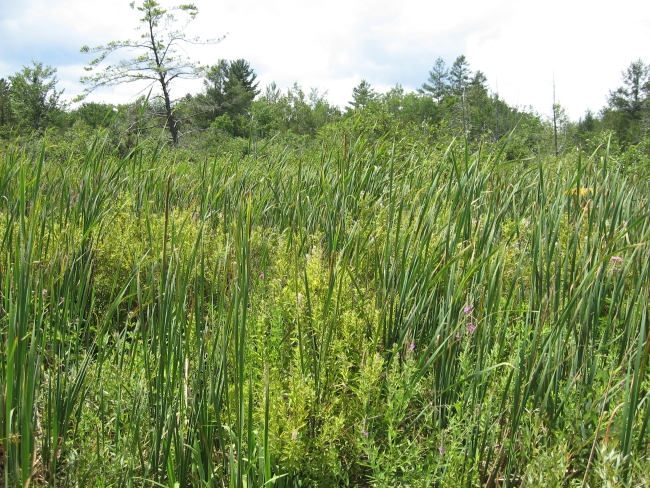
......................................................................
|
Slow flowing water at the culvert (looking south) –
a teneral Brush-tipped Emerald (Somatochlora walshii) was found near this spot.
|
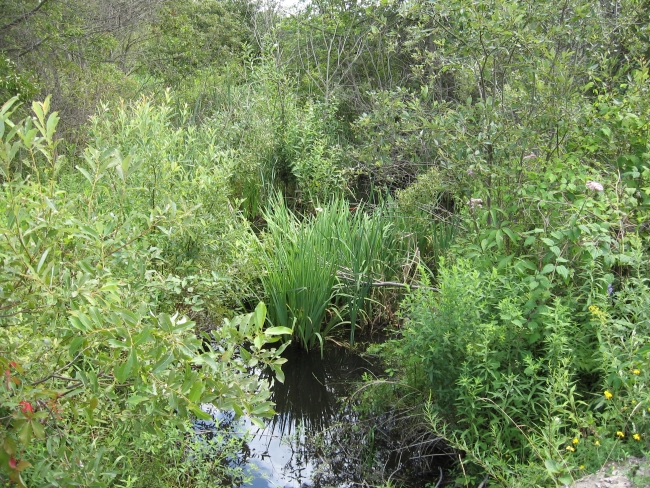
|
Tweed, Ontario, east of town along trans-Canada Trail:
small sand-bottomed woodland stream as well as standing or slowly moving water in trailside ditches and shaded areas.
Sunlit open spaces are created by the trail.
|
|
Sand-bottomed woodland stream –
home of the Arrowhead Spiketail (Cordulegaster obliqua),
dozens of Cordulegaster maiads have been found in the sandy substrate.
|
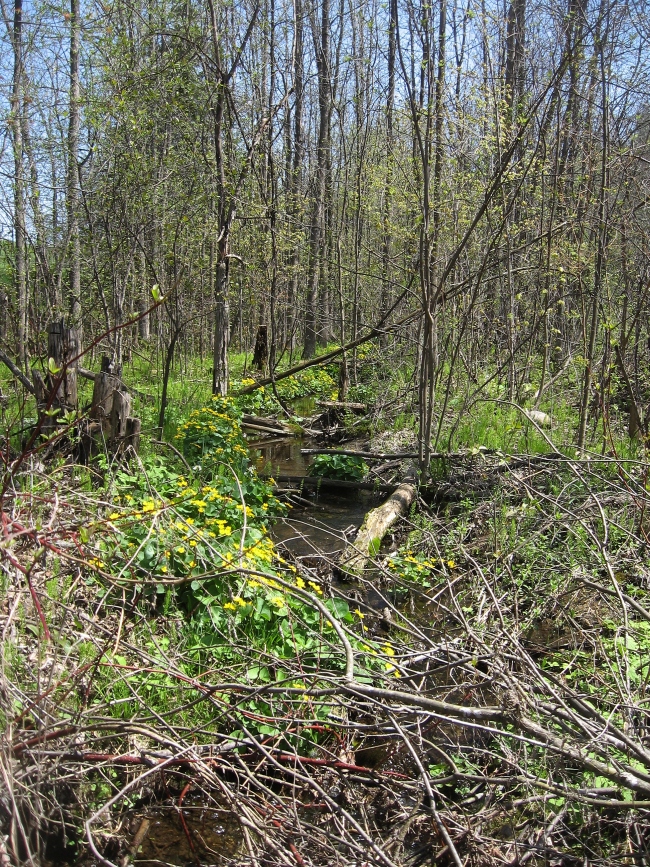
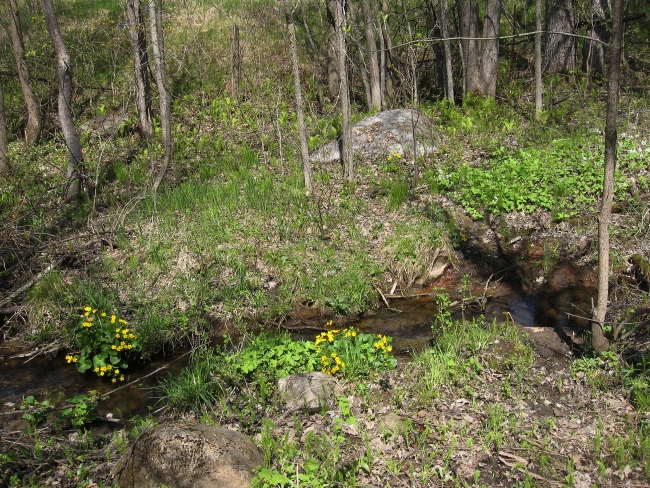
......................................................................
Other dragonfly species encountered in this general area are the Mustached Clubtail (Gomphus adelphus),
Stream Cruiser (Didymops transversa), Springtime Darner (Basiaeschna janata),
Chalk-fronted Corporal (Ladona julia) and the Racket-tailed Emerald (Dorocordulia libera).
Three species of the Baskettail species are represented: the Common Baskettail (Epitheca cynosura),
the Beaverpond Baskettail (Epitheca canis) and the Spiny Baskettail (Epitheca spinigera).
Common damselflies seen here are the Northern Bluet (Enallagma annexum) and the Marsh Bluet (Enallagma ebrium),
also look for the Slender Spreadwing (Lestes rectangularis) and the Amber-winged Spreadwing (Lestes eurinus).
|
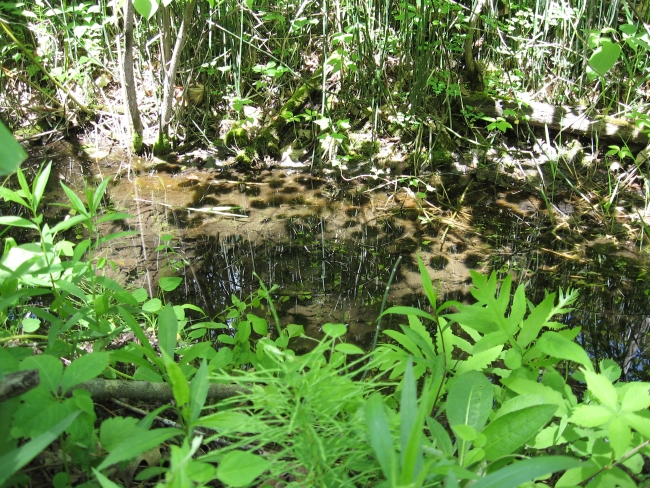
|
There are many still water pools, often transient, in the woodlands.
|
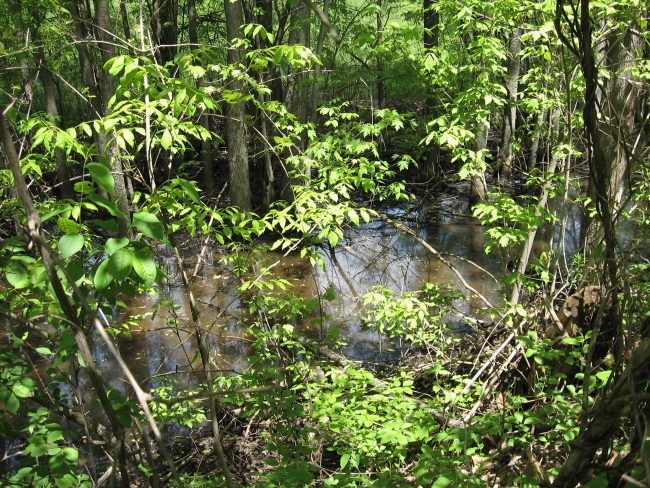
East of Tweed, Ontario, near intersection of Sulphide Road and the trans-Canada Trail:
sand-bottomed woodland stream.
Several Cordulegaster naiads have been found here, but no adults observed flying to date.
|
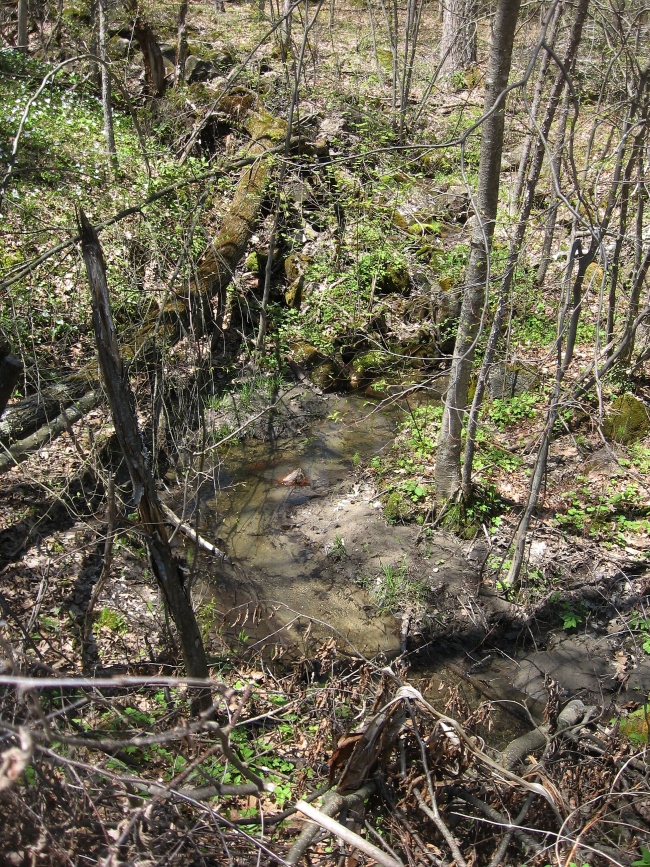
East of Tweed, Ontario, near the intersection of Alexander Street and the trans-Canada Trail:
disturbed field supporting tall grasses and wildflowers, bordered by shrubs and trees with a sand and rock-bottomed creek to the east.
Dragonfly species found near the stream are the
Arrowhead Spiketail (Cordulegaster obliqua), Swift River Cruiser (Macromia illinoiensis),
Racket-tailed Emerald (Dorocordulia libera) and the Lilypad Clubtail (Arigomphus furcifer).
Expect to find Lancet Clubtails (Gomphus exilis), Calico Pennants (Celithemis elisa), Common Green Darners (Anax junius) and several Aeshna and Sympetrum species foraging in the field nearby.
Damselflies encountered here are the Azure Bluet (Enallagma aspersum), Northern Bluet (Enallagma annexum) and the Eastern Forktail (Ischnura verticalis).
|
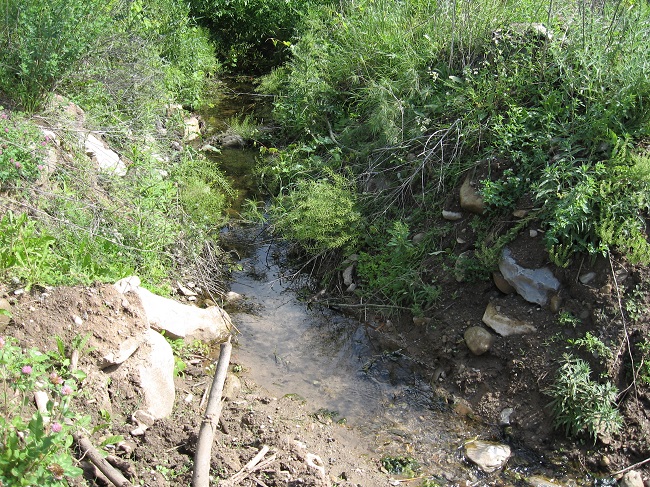
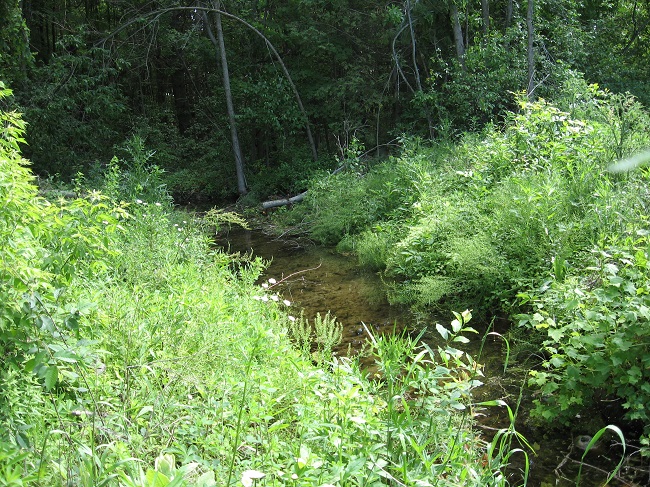
West of Tweed, Ontario, a beaver meadow along the trans-Canada Trail:
slow flowing and still pools of water supporting Cattails, rushes and sedges, bordered by deciduous forest.
Lance-tipped Darners (Aeshna constricta), Racket-tailed Emeralds (Dorocordulia libera),
Common Whitetails (Plathemis lydia) and Sympetrum species have been observed along the trail in this area.
However, due to its inaccessibilty most of the species that could potentially be breeding at this wetland are unknown.
|
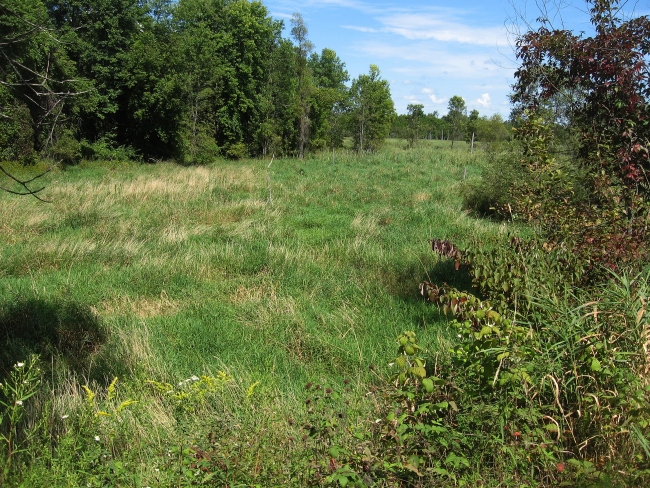
Marsh east of Sulphide, Ontario:
open expanses of shallow water, shoreline vegetation consists of shrubs such as willow and Speckled Alder.
Typical emergent plants are Cattails, sedges and rushes, aquatics include pondweed and Yellow Water Lily.
The odonate species flying here are the same as at the marsh ½ km west of town along the trans-Canada Trail.
|
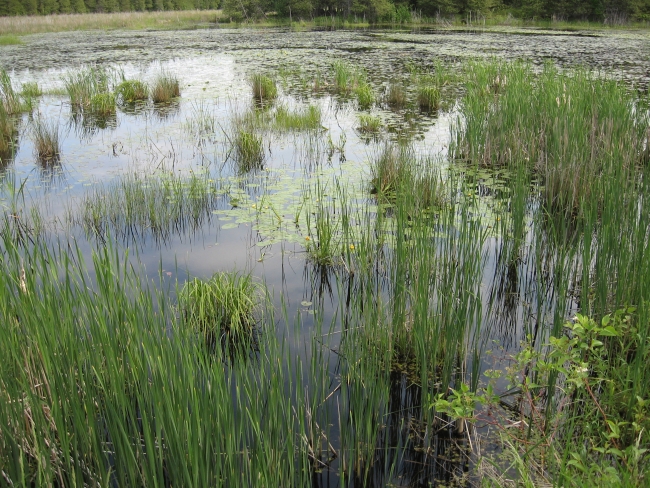
A marsh south of Bridgewater Road, about 1 km east of Actinolite, Ontario:
this wetland supports sedges, rushes, Cattails, and other emergent vegetation,
tall grasses and wildflowers along the shoreline and bordered by mixed woodland.
As of this date this is one of two known local habitats where the Elfin Skimmer (Nannothemis bella) may not only be encountered but is abundant and thriving.
Family Libellulidae is well represented at this site: Dot-tailed Whiteface (Leucorrhinia intacta), Frosted Whiteface (Leucorrhinia frigida), Belted Whiteface (Leucorrhinia proxima), Twelve-spotted Skimmer (Libellula pulchella), Four-spotted Skimmer (Libellula quadrimaculata) and Chalk-fronted Corporal (Ladona julia).
Damselflies encountered at this location are the Marsh Bluet (Enallagma ebrium), Eastern Forktail (Ischnura verticalis) and Sedge Sprite (Nehalennia irene).
Northern Spreadwings (Lestes disjunctus) and Slender Spreadwings (Lestes rectangularis) forage in the tall shoreline vegetation,
Spotted Spreadwings (Lestes congener) are common in the nearby shrubs and wooded areas.
|
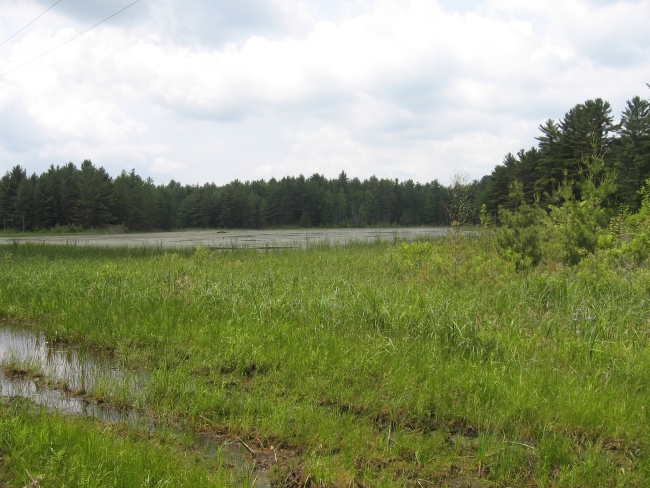
North of Tweed, Ontario, a marsh on Upper Flinton Road, about 150 m east of Moores Road:
a typical local marsh with some open expanses of shallow water.
Emergent plants such as Cattails, sedges and rushes grade into shoreline vegetation consisting of tall grasses and wildflowers, mixed with shrubs such as willow and Speckled Alder.
The marsh is bordered by mixed deciduous and evergreen forest.
Although surveyed rather briefly, several male and female Calico Pennants (Celithemis elisa) were spotted within an hour.
Other dragonfly species observed were the
Dot-tailed Whiteface (Leucorrhinia intacta), Frosted Whiteface (Leucorrhinia frigida), Belted Whiteface (Leucorrhinia proxima), Four-spotted Skimmer (Libellula quadrimaculata) and the Chalk-fronted Corporal (Ladona julia).
Damselflies inhabiting this marsh are the Eastern Forktail (Ischnura verticalis) and the Sedge Sprite (Nehalennia irene),
other Enallagma were sighted but not identified to species level.
|
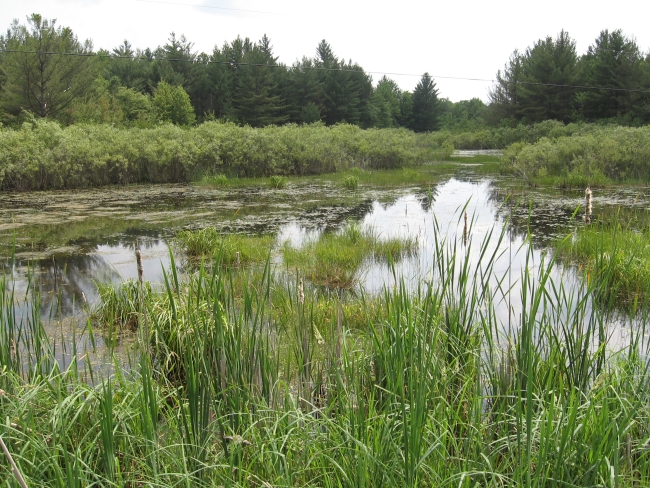
North of Tweed, Ontario, the Skootamatta River at Storrings Bridge:
the river in this area is rock-bottomed with emergent rocks, relatively shallow fast flowing water and rapids.
The rocky shoreline is barren in many places, but does support some grasses, wildflowers and shrubbery which quickly grade into mixed hardwood and deciduous forest.
A male Swift River Cruiser (Macromia illinoiensis) was observed at this site.
Other dragonflies commonly encountered here are the Belted Whiteface (Leucorrhinia proxima),
Four-spotted Skimmer (Libellula quadrimaculata), Chalk-fronted Corporal (Ladona julia) and the Racket-tailed Emerald (Dorocordulia libera).
The damselflies are, as expected, species which favour similar river shorelines elsewhere:
the Ebony Jewelwing (Calopteryx maculata) and the Powdered Dancer (Argia moesta).
|
|
Storrings Bridge, looking north
|
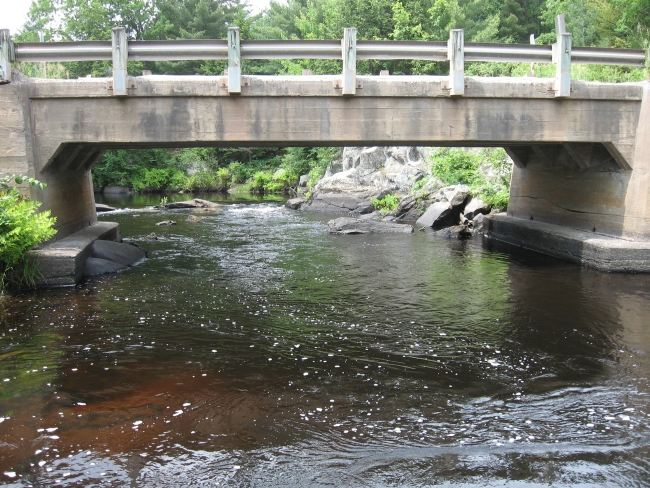
|
Skootamatta River, looking north of Storrings Bridge
|
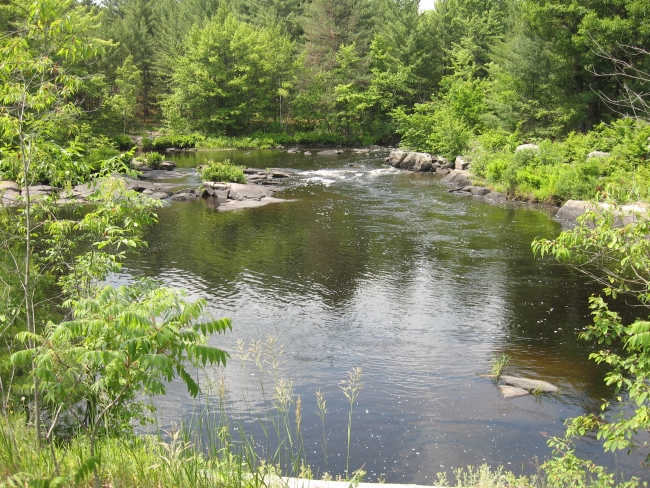
|
Skootamatta River, small waterfall north of Storrings Bridge
|
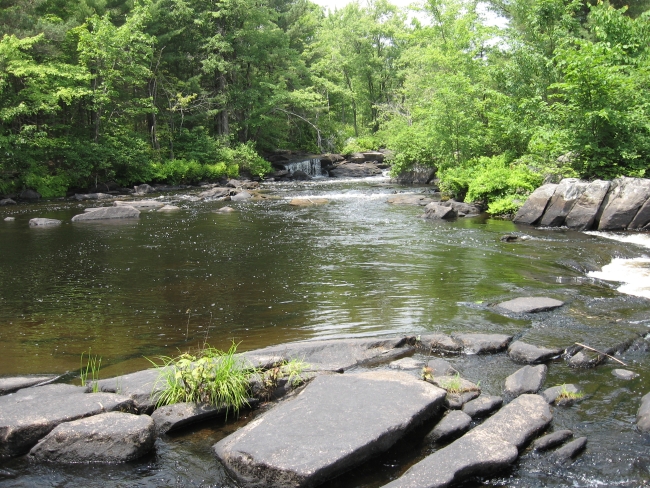
|
Skootamatta River, shallow rapids south of Storrings Bridge
|
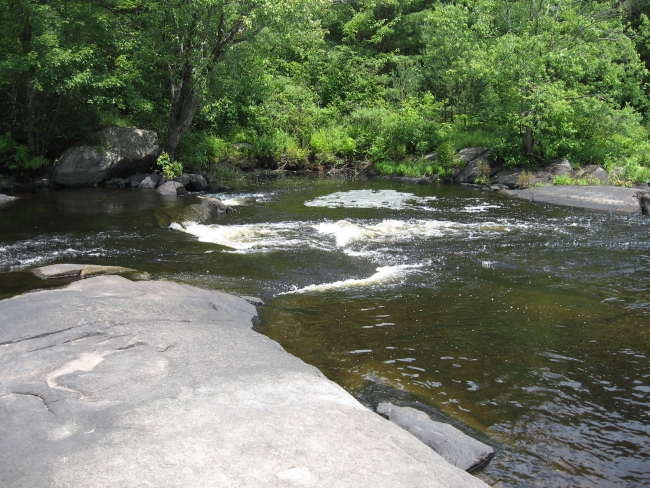
|
Near Actinolite, Ontario, the Skootamatta River at the Price Conservation Area:
generally the habitat and odonate species are typical of those encountered elsewhere along similar stretches of the Skootamatta and Moira Rivers.
However, some parts of the river are slower and deeper, and the shoreline supports emergent plants and meadows as well as mixed woodlands.
|
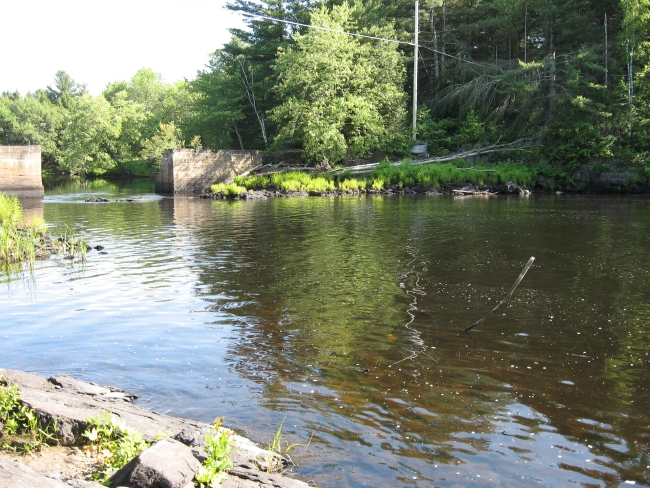
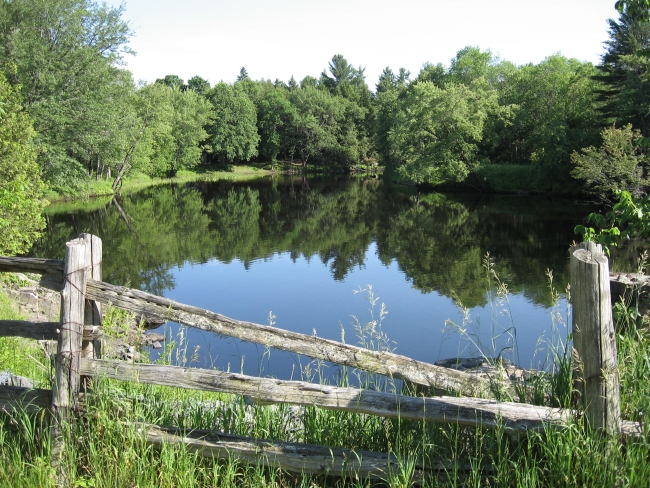
Vanderwater Conservation Area:
Moira River, rock-bottomed with fast flowing water, rapids and emergent rocks, but also quiet pools and backwaters.
The shoreline vegetation consists of wooded areas and clearings supporting tall grasses and wildflowers.
There are also slower stretches of river lined with emergent vegetatation (depicted below)
and some spring fed woodland streams and seeps.
Dragonfly species frequenting the shoreline include the Lilypad Clubtail (Arigomphus furcifer), Dragonhunter (Hagenius brevistylus),
Mustached Clubtail (Gomphus adelphus) and the Eastern Least Clubtail (Stylogomphus albistylus).
The Common Green Darner (Anax junius), Lance-tipped Darner (Aeshna constricta), Prince Baskettail (Epitheca princeps),
Slaty Skimmer (Libellula incesta) and Band-winged Meadowhawk (Sympetrum semicinctum) forage in the small meadows nearby.
Damselflies to watch for are the Ebony Jewelwing (Calopteryx maculata), River Jewelwing (Calopteryx aequabilis),
Aurora Damsel (Chromagrion conditum), Violet Dancer (Argia fumipennis violacea),
Powdered Dancer (Argia moesta), Stream Bluet (Enallagma exsulans) and the Fragile Forktail (Ischnura posita).
|
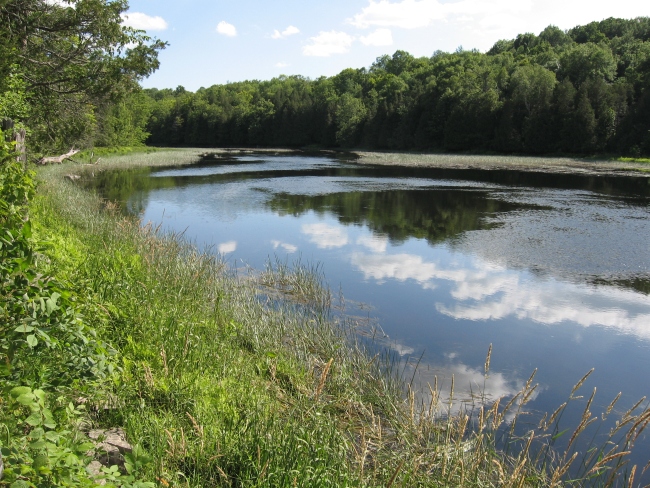
East of Tweed, Ontario, a marsh on Marlbank Road, east of VanderWey Ct:
a typical local marsh with some open expanses of shallow water.
Aquatics include pondweed and Yellow Water Lily.
Emergent plants such as Cattails and rushes grade into shoreline vegetation consisting of tall grasses and wildflowers, mixed with shrubs such as willow and Speckled Alder.
The marsh is bordered by mixed deciduous and evergreen forest.
The dragonflies encountered here are typical of those seen at other local marshes:
Belted Whiteface (Leucorrhinia proxima), Four-spotted Skimmer (Libellula quadrimaculata), Chalk-fronted Corporal (Ladona julia) and the Racket-tailed Emerald (Dorocordulia libera).
A Calico Pennant (Celithemis elisa) was observed foraging in the shoreline grasses.
The Eastern Forktail (Ischnura verticalis), Sedge Sprite (Nehalennia irene) and various Enallagma species are abundant.
A male Aurora Damsel (Chromagrion conditum) was encountered at this locale.
|
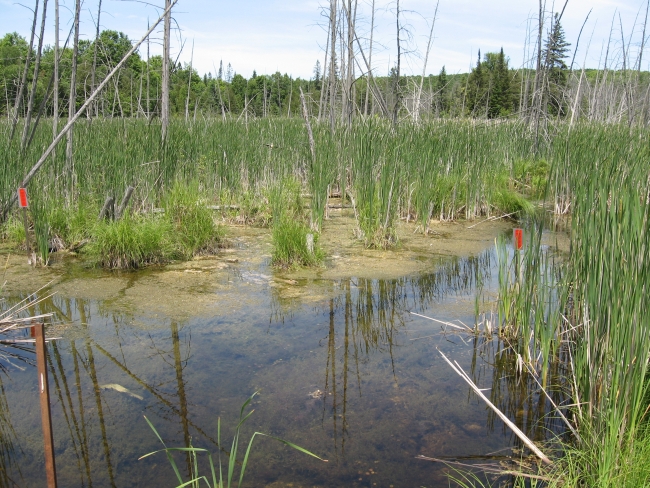
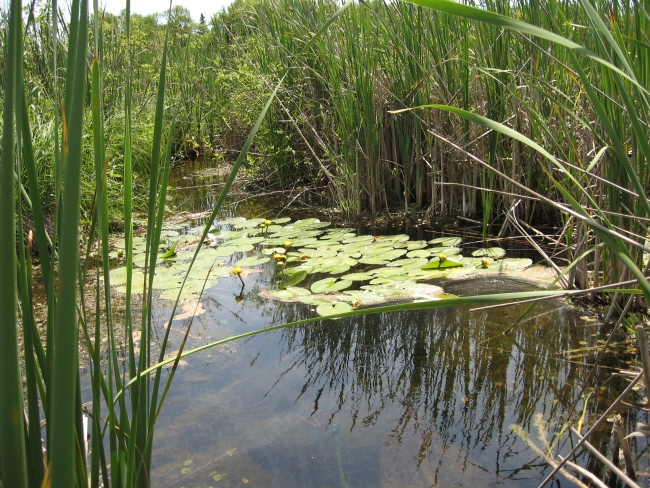
East of Crookston, Ontario, a marsh south of the Crookston Road:
a typical local marsh supporting Cattails, sedges, rushes and other emergent vegetation, various small willows, alders and dogwoods.
Some dragonflies recorded from this habitat include the Racket-tailed Emerald (Dorocordulia libera),
Chalk-fronted Corporal (Ladona julia), Dot-tailed Whiteface (Leucorrhinia intacta) and the Four-spotted Skimmer (Libellula quadrimaculata).
Taiga Bluets (Coenagrion resolutum), Boreal Bluets (Enallagma boreale) and
Sedge Sprites (Nehalennia irene) have been observed flying in the shoreline vegetation.
|
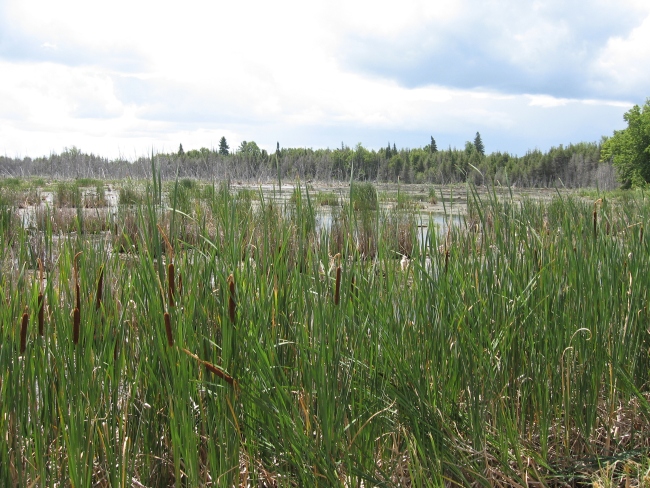
Stoco Fen, east of Tweed, Ontario, on East Hungerford Road:
relatively little open water compared to a marsh.
Wetland supporting sedges, orchids, Bog Labrador Tea, Pitcher Plants
and other fen indicator species, trees are mainly Tamarack and Eastern White Cedar.
This is the site of a sole encounter with a Forcipate Emerald (Somatochlora forcipata),
and the second known habitat where one can expect to find the Elfin Skimmer (Nannothemis bella).
Other dragonflies apt to be seen flying near the fen are the Brush-tipped Emerald (Somatochlora walshii), Eastern Amberwing (Perithemis tenera),
Common Baskettail (Epitheca cynosura), Widow Skimmer (Libellula luctuosa), American Emerald (Cordulia shurtleffi),
Band-winged Meadowhawk (Sympetrum semicinctum), Common Green Darner (Anax junius) and some Aeshana not identified as to species.
Damselfly species include the Sweetflag Spreadwing (Lestes forcipatus), Slender Spreadwing (Lestes rectangularis), Eastern Forktail (Ischnura verticalis), Sedge Sprite (Nehalennia irene) and some unidentified Enallagma.
Taiga Bluets (Coenagrion resolutum) have been observed at a marsh just west of the fen.
|
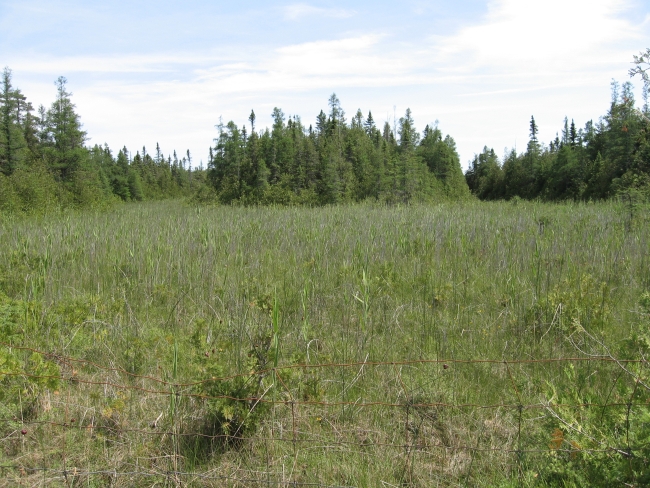
Boardwalk across the marsh at the H.R. Frink Center:
the flora and fauna are typical of other local wetlands,
Water Shield, Frogbit and Yellow Water Lily seem to do particularly well here.
The boardwalk makes it possible to study areas of the marsh that would normally be inaccessible except by canoe.
The odonate population is similar to that of other local marshes, for example, the
Common Baskettail (Epitheca cynosura), Prince Baskettail (Epitheca princeps),
Belted Whiteface (Leucorrhinia proxima), Common Green Darner (Anax junius),
Elegant Spreadwing (Lestes inaequalis) and Rainbow Bluet (Enallagma antennatum).
|
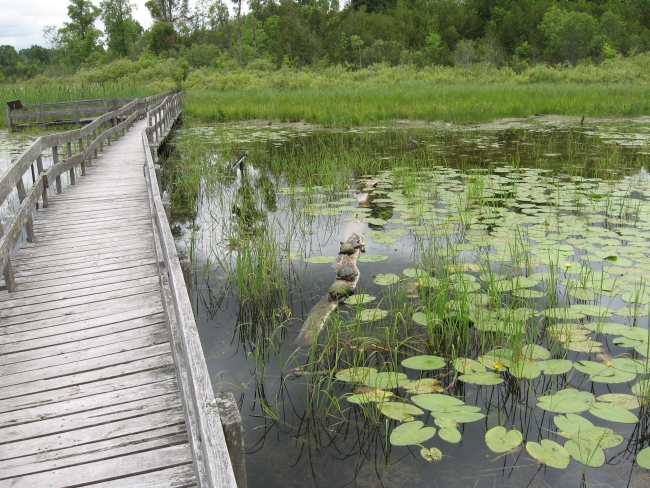
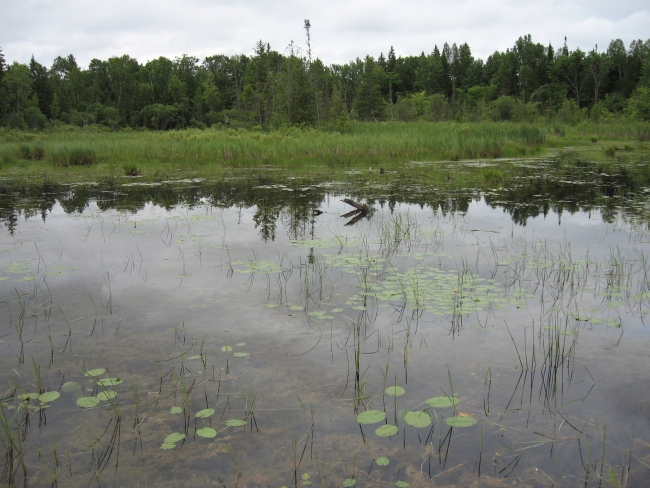
Clare River, east of Tweed, Ontario:
a small river, relatively shallow with a moderate to slow current,
supporting plenty of aquatic and emergent plant species,
bordered by lush shoreline vegetation consisting of meadows with tall grasses and wildflowers, and woodlands.
In some areas the shoreline consists of open expanses of flat rock.
Dragonfly species inhabiting this river include the
Slaty Skimmer (Libellula incesta),
Four-spotted Skimmer (Libellula quadrimaculata),
Twelve-spotted Skimmer (Libellula pulchella),
Widow Skimmer (Libellula luctuosa),
Eastern Pondhawk (Erythemis simplicicollis)
and the Lancet Clubtail (Gomphus exilis).
Many of the damselflies encountered here are species typically associated with rivers –
Ebony Jewelwing (Calopteryx maculata),
River Jewelwing (Calopteryx aequabilis),
Swamp Spreadwing (Lestes vigilax),
Powdered Dancer (Argia moesta),
Violet Dancer (Argia fumipennis violacea),
Stream Bluet (Enallagma exsulans),
Rainbow Bluet (Enallagma antennatum),
Sedge Sprite (Nehalennia irene),
Fragile Forktail (Ischnura posita),
and the ubiquitous Eastern Forktail (Ischnura verticalis).
|
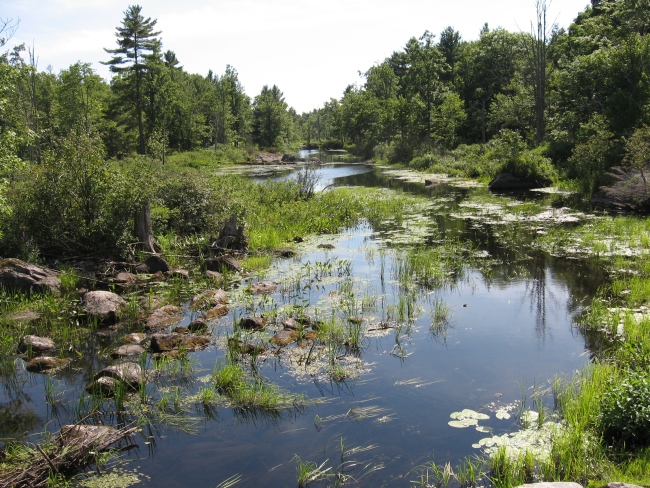
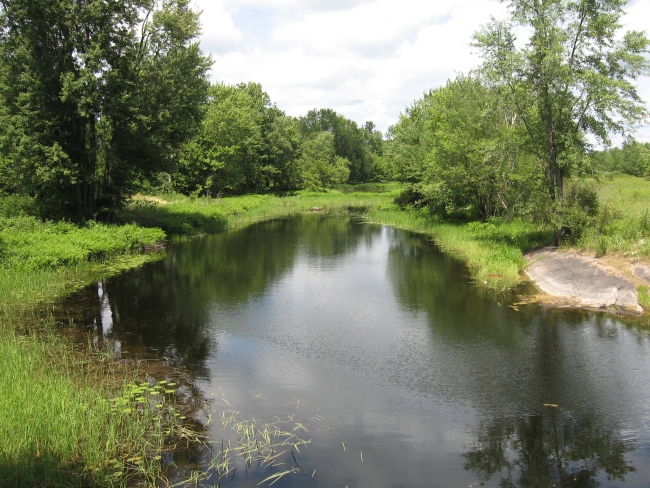
|






































